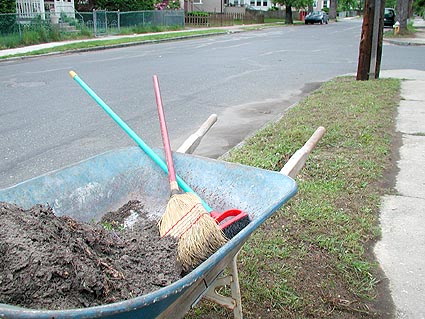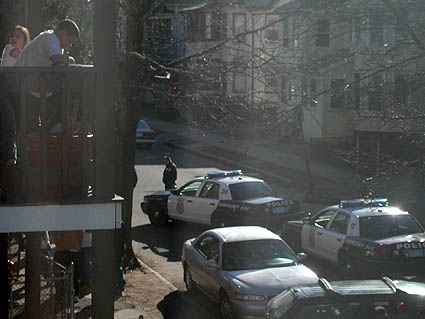
Since 2003, New York City has had in place a 311 line for citizens to call in with quality of life problems. The line receives 40,000 calls daily, according to an article in today’s New York Times. The article, by Ray Rivera, announces that both 311 and 911 can now receive digital photos and videos from callers. From the article:
“If you see a crime in progress or a dangerous building condition, you’ll be able to transmit images to 911, or online to nyc.gov,” the [Mayor Michael Bloomberg] said in his annual State of the City address. “And we’ll start extending the same technology to 311 to allow New Yorkers to step forward and document nonemergency quality of life concerns, holding city agencies accountable for correcting them quickly and efficiently.”
John Feinblatt, the mayor’s criminal justice coordinator, could not say how long it will take to implement the plan, but said it would be fairly inexpensive because the technology already exists.
Springfield Police Commissioner Edward Flynn spent the last month visiting the city’s sector beat management team meetings, introducing each of the three newly-appointed deputy chiefs in his geographic area, and hearing from residents about their wants and needs. (Resident Herb Singleton blogged a little about his experience sitting in on the Sector H meeting.)
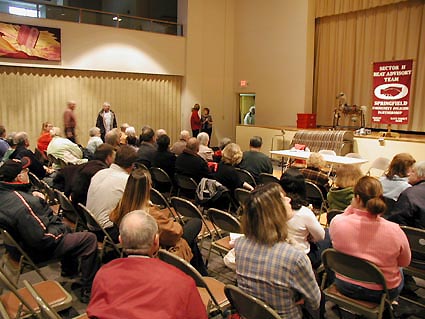
Calling community meetings "strong opportunities to demonstrate the government’s competence and interest," Flynn said that one challenge the city faces is developing a partnership where code enforcement can trust the police department‘s judgment, so that if police give code enforcement a priority, "it’ll be good for them, and they’re not going to get attacked for not doing some other thing."
By visiting community meetings, Flynn explained, the police are the first ones on the scene, in a way, for some quality of life problems. "We’re getting the brunt of, ‘You’re the government,’" he said. His department is trying to foster the notion that as a 24-hour-a-day agency, with the right to use force and authority, the police are a neighborhood asset.
"It’s important for people to know that a senior commander is accountable for their neighborhood," Flynn said. "Not simply a police officer who has to negotiate a chain of command, but a senior accountable manager. When I go to a meeting with their deputy chief, I think it provides a measure of hope that there will be sustained attention to ongoing issues."
But what Flynn has discovered is that a lot of those ongoing issues are not necessarily criminal activity.
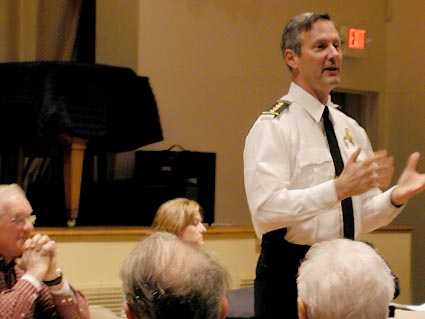
Inevitably, he said, issues are brought to the attention of the police that are not "narrowly and specifically" police issues, but contribute "to the environment of disorder and lack of control." This includes housing—whether it’s abandoned, or in an advanced state of disrepair—and code enforcement challenges. Flynn said these issues are brought to the police "assertively and with a sense of great frustration." People are looking for help navigating the system.
"One of the challenges is to invite the sustained attention of other agencies that aren’t organized to have access to community groups, and don’t have the resources I have," Flynn said. When police commanders make demands on other agencies to attend to community problems, he explained, sometimes those other agencies feel the stress of not being able to accomplish tasks fast enough for the neighborhood.
An aspect of the challenge, then, he continued, is to negotiate a way of acknowledging the stress that arises within a department struggling to meet the need—while also creating a culture where if police identify a problem as a priority for a neighborhood, it becomes a priority.

Flynn described the contrast: problems conveyed from the police to code enforcement officials may often end up on as item 100 on a list of neighborhood problems to fix. "I think a lot of bureaucrats perfectly logically just take things as they come in," he said. "I’ve got a list of 100, and yours is now 100, and we get to it as soon as we get to the other 99."
But in a community meeting, he said, if 99 people are clamoring about that number 100, then maybe that item should be number one. Fixing those symbolic demonstrations of government inattention, he added, "really jacks up neighborhood morale."

"Government, and police specifically, are in the neighborhood morale business as much as we are in the neighborhood safety business. If we don’t keep people hopeful—when their cars get broken into, when their sheds get broken into—they’ll take it, up to a point, if they think the rest of things are functioning pretty well. But if it seems like everything they complain about is on a list that someday gets attended to, sooner or later, they say, I’ve got options, you know?"
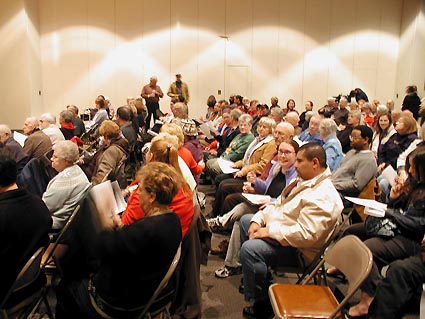
The value of community meetings, Flynn said, is underscoring the fact that somebody cares, and is paying attention. His response to people listing off dozens of complaints is to say, "You just raised 20 issues. We can’t do 20 issues, alright? My officers here will follow up on you. Let’s pick one or two, and make some progress. And when we get them done, maybe we can do one or two more."
He said it is key to convey that on one hand, the problems are acknowledged, and on the other, he does not have a magic wand, and cannot fix the problems overnight. "But if you’re concerned enough to stick around, I’m concerned enough to have people steadily assigned to this neighborhood. Many of the complaints are about those things, rather than burglaries, break-ins, and shootings. We end up being the trip-wire for a lot of these things."
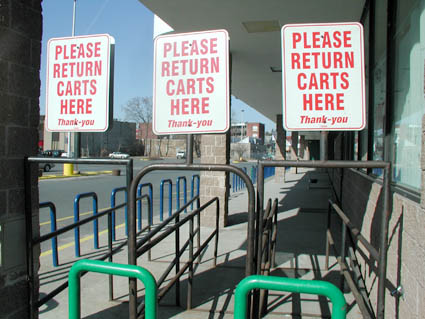
It sounds like Flynn’s recommendation is to systematize a way for problems to surface and be identified from citizens, ranging from criminal activity to code enforcement issues. Residents do not typically know how these problems are categorized; they only know that they are problems. It is perhaps partly the city officials’ task both to educate residents about how to categorize neighborhood problems (a baffling task, which seems to require a PhD), understanding the range of quality of life issues and where they fall under city departments; and also to coordinate amongst themselves clearly and efficiently.
Is this too much to ask, too ambitious a goal to set?
New York City’s 311 line may be a good model to consider along those lines, but it sounds like one of the first things that could be accomplished is for the police department and code enforcement officials to sit down and share some best practices.
